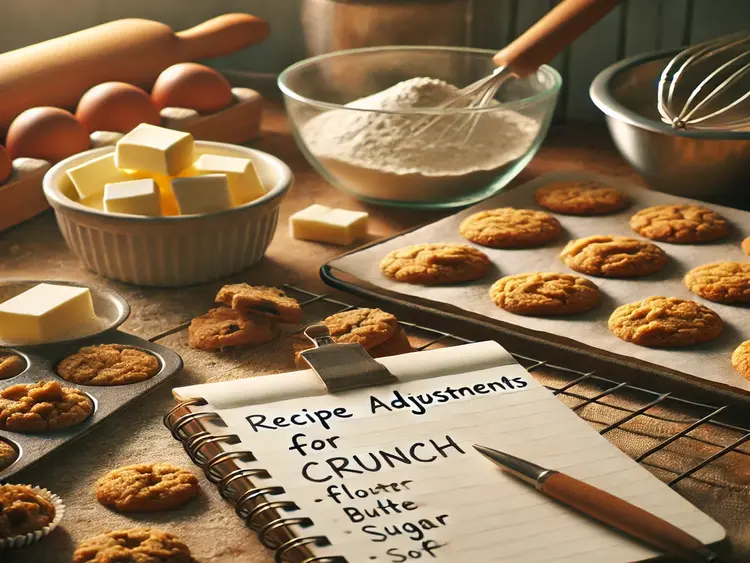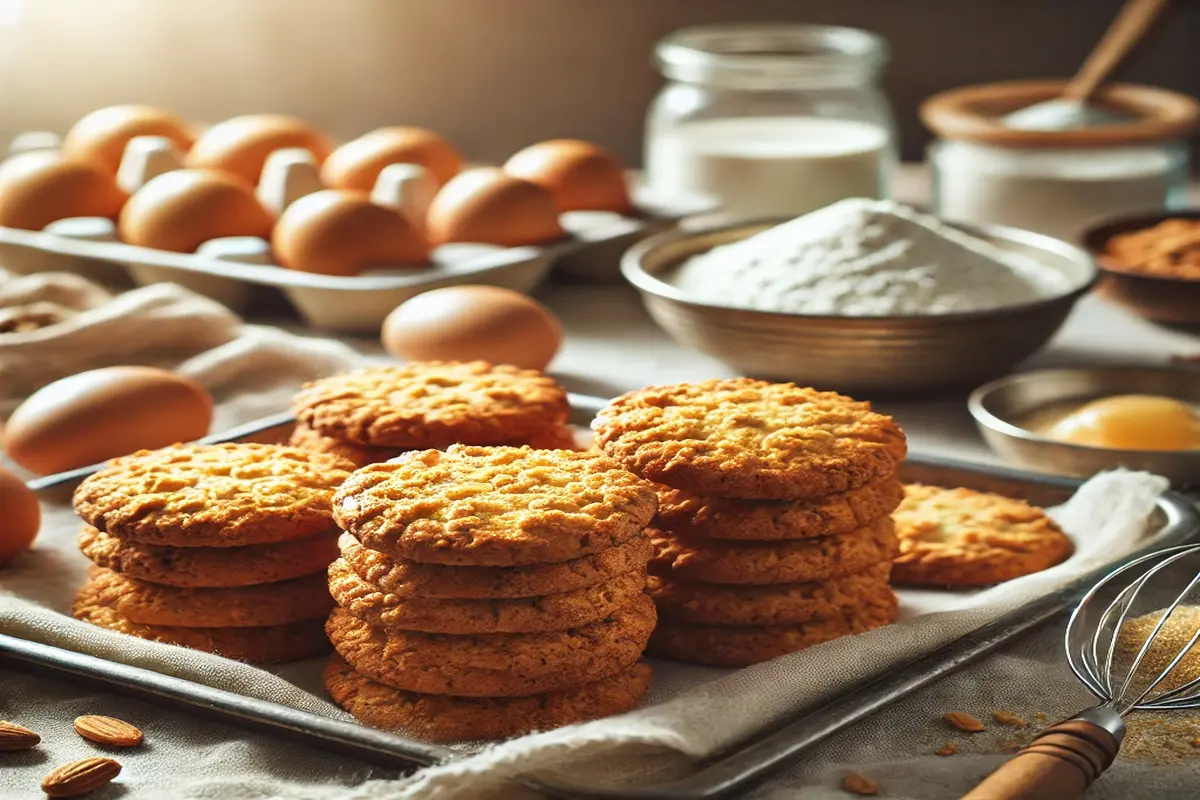Creating the perfect cookie texture—whether soft or crunchy—depends on several key factors, from the ingredients used to the baking techniques. While soft cookies have their fans, there’s something uniquely satisfying about biting into a cookie with a delightful crunch. So, what makes cookies crunchy instead of soft? The answer lies in balancing ingredients, moisture, and baking methods. In this guide, we’ll dive into all the secrets behind creating perfectly crunchy cookies, along with tips for adjusting any recipe to achieve that satisfying crispiness.
The Role of Ingredients in Crunchy Cookies
1. Sugar and Its Impact on Cookie Texture
The type of sugar used plays a crucial role in determining cookie texture. Granulated sugar creates a crispy texture by allowing the dough to spread and caramelize during baking. In contrast, brown sugar, which contains molasses, retains moisture and results in softer cookies.
For crunchier cookies, a higher ratio of granulated sugar is key. This ensures the dough spreads thinly and crisps up during baking. For more insights into ingredient roles, check out cookie baking science.
2. Flour: The Foundation of Crunch
The type of flour significantly affects whether cookies turn out crunchy or soft. All-purpose flour is commonly used, but if you’re aiming for extra crunch, consider using bread flour. Bread flour has a higher protein content, which provides a firmer structure and crunchier texture. If you prefer softer cookies, cake flour with its lower protein content will result in a more tender bite.
Similarly, the right choice of flour can make a difference in savory recipes, such as crispy Perdue Chicken Tenders.
3. The Role of Fat: Butter vs. Shortening
Fat significantly impacts cookie texture. Butter tends to produce soft and chewy cookies due to its low melting point, allowing the dough to spread more. However, using shortening results in crispier cookies because shortening has a higher melting point, which prevents excessive spreading. Many bakers use a combination of both fats for the perfect balance between crunch and flavor.
This balance in fat usage mirrors the role of fats in achieving the crispy coating in Perdue Chicken Nuggets.
The Science Behind Cookie Texture
1. The Maillard Reaction and Caramelization
The Maillard reaction and caramelization are two key processes responsible for creating a crispy cookie texture. While both contribute to browning, they function differently. The Maillard reaction occurs when the sugars and proteins in the dough are exposed to heat, leading to a rich browning and the formation of crispy edges. This reaction is crucial for developing the cookie’s complex flavor and texture. In addition, caramelization happens when sugar molecules break down under heat, adding to the golden color and contributing to a sweet, crunchy finish. Together, these processes help transform dough into perfectly crisp cookies. Caramelization, which refers to the browning of sugars, gives cookies their characteristic golden-brown hue.
Both processes work best when cookies bake for a longer time at a moderate temperature. This allows moisture to evaporate, leaving a crisp outer shell.
2. Moisture Control in Dough
Controlling moisture is key to ensuring your cookies turn out crispy. Reducing the number of eggs or using only egg whites can significantly decrease moisture, helping achieve a crunchy texture. Additionally, avoid moisture-retaining ingredients like honey or molasses, which can soften cookies. Adding dry ingredients like nuts, seeds, or coconut also helps absorb excess moisture, contributing to crunch.
For more tips on cookie techniques, explore crunchy cookie techniques.
Baking Time, Temperature, and Techniques for Crunchy Cookies
1. Baking Temperature: The Key to Crunch
Baking temperature plays a crucial role in what makes cookies crunchy instead of soft. For crunchier cookies, bake at a higher temperature—around 350°F to 375°F. Higher temperatures help the cookies set quickly, preventing them from spreading too much and creating a crispy exterior.
2. Extended Baking Time for Extra Crunch
A simple way to ensure crunchiness is to bake your cookies a bit longer than usual. Extending the baking time allows more moisture to evaporate, giving you a crispier result. Keep a close watch to avoid overbaking, which can lead to burned cookies.
Similarly, adjusting cooking time also plays a critical role in other recipes, like Country Pride Chicken Nuggets, where timing affects texture.
3. Chilling Dough for Maximum Crunch
Chilling cookie dough before baking is an effective way to enhance crispiness. By allowing the fats in the dough to solidify, chilling prevents the cookies from spreading excessively in the oven. Additionally, this method helps retain the dough’s structure during baking, which results in a firmer, crunchier cookie. Letting the dough rest for at least two hours—or even overnight—can also allow the flavors to develop, giving your cookies not only better texture but also richer taste. As a result, the cookies bake up thicker and crunchier. Chilling dough for at least two hours or even overnight works wonders.
This technique of chilling to maintain texture is also a best practice for dishes like Perdue Chicken Strips.
Adjusting Recipes to Make Cookies Crunchy Instead of Soft

1. Modifying Soft Cookie Recipes
If you’re working with a soft cookie recipe but want to make them crunchy, there are a few easy adjustments:
- Use more granulated sugar than brown sugar.
- Swap out butter for shortening or use a blend of both.
- Reduce the number of eggs or use only egg whites(The Cooking Facts).
2. Adding Crunchy Mix-ins
Incorporating mix-ins like nuts, seeds, or oats can enhance the crunch factor of your cookies. These ingredients not only add texture but also absorb moisture, helping create firmer, crunchier cookies.
Just like mix-ins in cookies, using the right coatings and mix-ins can significantly affect texture in recipes such as crispy Perdue Nuggets.
3. Alternative Flours and Sugars
Experimenting with alternative flours like whole wheat or spelt can also influence texture. These flours tend to produce denser, crunchier cookies due to their higher fiber content. Similarly, using less refined sugars, like coconut sugar, can result in crispier cookies
Choosing the Right Leavening Agents for Crunchy Cookies
1. Baking Soda vs. Baking Powder
The type of leavening agent you use in your cookie recipe can significantly impact the final texture. Baking soda, an alkaline ingredient, reacts with acids in the dough to produce carbon dioxide, creating a crispy texture. On the other hand, baking powder—a combination of baking soda and an acid—produces a fluffier, more cake-like result. For crunchier cookies, using baking soda alone is often preferable, as it allows the dough to spread and crisp up more.
2. Adjusting Quantities for Desired Texture
The amount of leavening agent you use also influences cookie texture. Using too much baking soda or baking powder can cause cookies to spread excessively, resulting in thinner, crispier cookies. Conversely, using less leavening can create denser cookies with a chewier texture. For perfectly crunchy cookies, start with a small amount of baking soda and adjust according to the desired level of crispness.
3. Experimenting with Leaveners
Experimenting with different combinations of leaveners can help you achieve the ideal balance of crunch and rise. For example, some bakers combine both baking soda and baking powder to create cookies that are crunchy on the outside but maintain a slightly soft center. Testing various quantities will allow you to fine-tune your recipe for the perfect texture.
Common Mistakes and How to Avoid Them
1. Overmixing the Dough
Overmixing the dough can develop too much gluten, resulting in tough cookies instead of crisp ones. Always mix until just combined to prevent a dense texture.
2. Overbaking vs. Underbaking
It’s essential to find the right balance between overbaking and underbaking. Overbaking can make cookies too hard, while underbaking leaves them soft and gooey. Remove cookies from the oven when the edges are lightly browned to achieve the perfect crunch.
This is similar to balancing cooking times for texture in savory recipes like Purdy Chicken.
3. Proper Storage for Crunchy Cookies
To retain their crunch, cookies must be stored properly. Once fully cooled, store them in an airtight container at room temperature. Avoid refrigeration, as this can introduce moisture and soften cookies
What Makes Cookies Crunchy Instead of Soft? Perfecting Cookie Thickness for Crunch
1. Portioning Dough for Even Crunch
Evenly portioning cookie dough is essential for achieving consistent texture across all cookies in a batch. Using a cookie scoop ensures uniform size, which helps cookies spread and bake evenly. This leads to a uniform crunch throughout the batch, as smaller cookies will tend to crisp faster than larger ones.
2. Rolling Dough for Thinner Cookies
For bakers seeking extra crunch, rolling the dough into thinner portions before baking can help. Thinner dough spreads more quickly in the oven, resulting in a crispier cookie. If you’re looking to avoid over-spreading, ensure that the dough is well-chilled before rolling it out. This keeps the cookies from becoming too thin during baking.
3. Creating Space for Spreading
When baking, it’s important to leave ample space between cookie portions on the baking sheet. Cookies that are too close together will end up crowded, which can cause uneven spreading and texture. Leaving at least 2-3 inches of space between each cookie ensures they bake and crisp up evenly
FAQs: What Makes Cookies Crunchy Instead of Soft?
What ingredient makes cookies crunchy?
Using more granulated sugar, combined with bread flour and shortening, helps create a crisp texture.
How do you keep cookies from getting soft?
Store cookies in an airtight container at room temperature, ensuring they are fully cooled before storage.
Why do my cookies turn out soft?
Cookies can become soft due to too much moisture in the dough, underbaking, or using too much brown sugar or eggs.
Conclusion: Achieving the Perfect Crunch
Achieving the perfect crunchy cookie requires attention to detail in every aspect of the baking process, from selecting the right ingredients to applying the proper techniques. Each element, whether it’s the type of sugar used, the choice of flour, or the baking temperature, plays a crucial role in transforming a soft, chewy cookie into a delightfully crispy treat. By understanding what makes cookies crunchy instead of soft, you gain the flexibility to customize any cookie recipe to match your preferred texture. For more insights on baking science, explore this cookie baking science guide and additional crunchy cookie tips.
tweaking key ingredients such as leavening agents and fats allows you to further refine the cookie’s structure and flavor. For instance, using a higher ratio of granulated sugar compared to brown sugar, or opting for shortening over butter, can make a significant difference in the cookie’s crispiness. Moreover, implementing techniques like chilling the dough, adjusting baking times, and creating enough space for cookies to spread during baking can ensure even crunch throughout each batch.
It’s also worth noting that beyond basic ingredient modifications, incorporating mix-ins such as nuts, seeds, or oats can enhance both the texture and flavor profile of your cookies, providing added crunch and complexity. Whether you are modifying a traditional recipe or experimenting with new flavors, these small changes can take your baking to the next level.

Can you be more specific about the content of your article? After reading it, I still have some doubts. Hope you can help me.
Absolutely, what can i help you with?